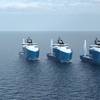Wärtsilä Corporation introduces a new compact, high-performance waterjet that is optimized for fast vessels. The new Wärtsilä LJX waterjet offers, in comparison with other waterjets available today, a 25 percent reduction in mounting flange diameter, a 10 percent overall weight reduction and a 35 percent increase in cavitation margin. The LJX waterjet allows further innovation in fast vessel design.
The new Wärtsilä LJX waterjet is being developed to allow an optimum number of waterjets to be chosen for a given propulsion power requirement without requiring an excessive transom width in high-speed vessels.
Generally, when selecting waterjets, the required power is distributed between multiple waterjet units to create an installation with lower weight, higher efficiency and, above all, lower costs than when using fewer, larger units. But multiple waterjets have a penalty in increased transom width, which is usually unacceptable in high-speed vessels as transom width is an important vessel design parameter.
In addition, waterjets currently available on the market are designed to cover all propulsive requirements for extremely high vessel speeds, up to more than 70 knots, and for very high powers on relative small diameters. However, the Wärtsilä LJX waterjets cut out the extremes in hydrodynamic design parameters and are based on a completely new design approach to create more compact jets with heavily increased cavitation margins.
The mechanical design of the Wärtsilä LJX waterjet is similar to the current Lips Jets series with all main parts of the stator and the steering assembly fabricated from stainless steel plates. This approach allows Wärtsilä to achieve minimum weight with maximum design flexibility. It is thus possible to have not only common steering/reversing and booster jets, but also jets for fast crash stop and reversing, jets with nozzle closing devices, and jets with inboard hydraulic systems. The oil-lubricated thrust bearing remains inboard in the jet room with a water-lubricated marine bearing supporting the shaft in the stator bowl; a design choice that is made for reasons of easy maintenance, access and reliability.
Vessel design possibilities
The new Wärtsilä LJX waterjet makes possible new and innovative fast-vessel designs. For example, 36 MW of propulsive power in a stabilised mono-hull is typically generated by four diesel engines. Four waterjets are then the logical solution but they rarely fit within the transom width. A typical compromise is the installation of two 9 MW wing jets and a single 18 MW central jet driven by a complex twin-input/single-output gearbox with two reduction ratios. An alternative of using an 18 MW gas turbine instead of the central two diesel engines is unpopular because of the fuel consumption penalty.
However, four Wärtsilä LJX jets of equal size will easily fit in the space normally taken by the three unequal-sized units because of the 25% smaller diameter of the compact Wärtsilä LJX design. The vessel's owner also benefits from greater redundancy and the lower logistics and maintenance costs of the uniform propulsion installation with all jets and gearboxes being identical and requiring similar parts.
Planing, speed and freedom
High-speed planing yachts may be built with two wing waterjets and a large, central waterjet. Yet, for most of the time, it will usually cruise at low speed on its wing jets alone, with the high-powered central jet being shut down. Installing Wärtsilä LJX waterjets on the wing propulsion lines will give such planing yachts increased freedom in the choice of cruising speeds owing to the greatly increased margins for cavitation which make high acceleration thrust available at low speeds.
Wärtsilä LJX waterjets also allow slightly larger wing waterjets to be chosen for even further increases in operating freedom and low-speed efficiency. Even with larger LJX wing waterjets, their compact design gives yacht designers benefits in reduced width and a lower height of the jet flange, freeing up more space aft in the yacht for the owner's and passengers' enjoyment.
First order
The first Wärtsilä LJX waterjets are being delivered for two Incat 112m high-speed wave-piercing catamarans for Japanese customers. The catamarans will be delivered in 2007 from Incat's Hobart, Tasmania, shipyard.
With a load-carrying capacity of 1500 tonnes, these will be the largest catamarans to be powered by diesel engines. They will each have capacity for more than 800 lane metres of trucks and other heavy vehicles, together with 150 cars, or, if trucks are not carried, for more than 400 cars alone. They will also be able to carry up to 1000 passengers.
Capable of speeds greater than 40 knots, the catamarans will each be equipped with four LJX waterjets having a 1500 mm diameter impeller and an inboard layout for steering and reversing hydraulics.
Featured videos

Tracking Foreign Vessels Working in the U.S. Jones Act Market

Inside the Electrified Truckable Tug

Inmarsat Enhances Service to Drive Digitalization
Subscribe for
Maritime Reporter E-News
Maritime Reporter E-News is the maritime industry's largest circulation and most authoritative ENews Service, delivered to your Email five times per week









